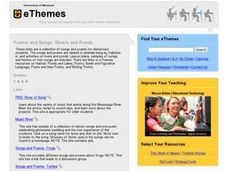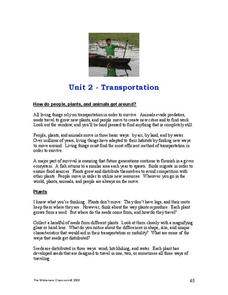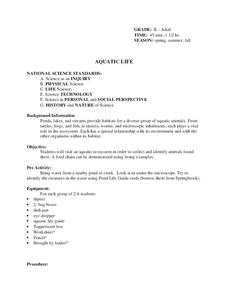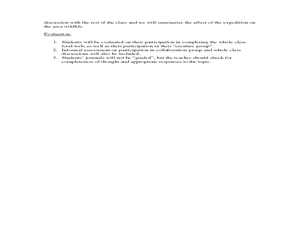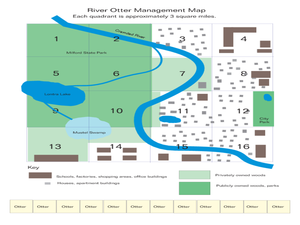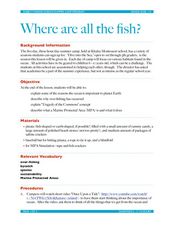Curated OER
Habitat for Plants! There's No Place Like Home!
Students compare and contrast conditions necessary for survival of aquatic and terrestrial plants, identify common and scientific names of plants,
and determine correlation between location and plant characteristics. Students then use...
Curated OER
Poems and Songs: Rivers and Ponds
Young scholars explore songs and poems related to the animals, habitats, and activities on rivers and ponds. They listen to song clips, explore various websites, read poems and song lyrics, complete worksheets, and define key vocabulary...
Alabama Learning Exchange
Amazing Adaptations - Probing Pinnipeds
Fourth graders collect data about the habitats of pinniped adaptations using digital probes. They determine how pinnipeds make adaptations to their natural environment by completing an experiment to determine how human and pinniped...
Curated OER
Transportation
Students read about various modes of transportation for people, plants, and animals. In this transportation lesson, students read information about the transportation modes for people plants, and animals using water and land. Students...
Curated OER
Habitat survival
Sixth graders study different environments and how the food chain affects the survival of different animals. In this environments lesson plan, 6th graders share the visuals which describe the characteristics of the environment that they...
Curated OER
Impact of Exotic Species on Lake Ecology
Students examine the effect of foreign species on various habitats. In groups, they identify the population dynamics of the zebra mussel. They calculate averages and graph data from Seneca Lake in New York. They develop hypothesis...
Curated OER
Aquatic Life
Learners explore aquatic life. In this science lesson, students visit an aquatic ecosystem and collect animals found there. Learners create a food chain for the aquatic ecosystem.
Curated OER
Observation Hike
Students participate in an observational hike to study the natural surroundings. In this observational hike lesson, students hike through a state park and observe the plant and animal life. Students learn about appropriate...
Curated OER
Animals and the Food Webs that Love Them
Students study the animals that Lewis and Clark would have encountered. For this animals lesson students study the food web and how human populations have affected them.
Curated OER
Special Place
Students observe and describe a "special place" chosen along a nature trail. In this habitat observational skills and writing lesson, students take a walk on a nature trail and choose a spot to sit and meditate. Students complete a...
Curated OER
Changing Sounds
Students identify how the pitch and the loudness of an instrument can be altered. In this online science of sound lesson, students employ the use of an interactive whiteboard to examine the loudness and pitch of a guitar, drum, and...
Curated OER
Butterfly Metamorphosis Booklet
Pupils study the four different stages of butterfly metamorphosis, In this butterfly life cycle lesson, students construct a metamorphosis booklet by recording and illustrating the butterfly life cycles in the booklet. Vocabulary and...
Curated OER
Mapping Deep-Sea Habitat
Learners create a two-dimensional topographic map and a 3-D model of landforms. In this creative lesson students create 2 and 3-D objects and learn how to interpret the data from these things.
Curated OER
Micro-organisms
Students discuss micro-organisms. In this micro-organisms lesson, students identify which micro-organisms are harmful and which ones are beneficial. Students complete a worksheet which is included in the lesson.
Curated OER
Investigating Our Past: Where Did Humans Come From?
Students brainstorm about evolution and explore the processes of evolution. In this investigative lesson students map out evolution and compare the two theories after researching them.
Curated OER
Too Many Otters
Second graders investigate the habitat of otters. In this animal science lesson, 2nd graders role play the job of wildlife biologists and try to manage the otter population. Students use a map to track their specific otter population.
Curated OER
Animal Games
Students explore a variety of games on the Internet that will teach them about animals; they focus on the Florida panther. Students choose the activity that is of interest to them, and then rotate between the games online and the...
Curated OER
Build An Island
Students explore erosion. In this science lesson, students build an island and observe the effects of erosion on the island. Students discuss freshwater ecosystems in Hawaii.
Curated OER
Who's Who?
Students explore biology by identifying animals and their environments. In this animal characteristic lesson, students read assigned text about farm animals, how they are raised, and what they are used for in our society. Students view a...
Curated OER
Specialized Structures and Environments
Fifth graders explore biology by completing an Internet activity in class. In this adaptation activity, 5th graders identify several organisms and mammals that fight for their existence through slow changes to their anatomy over the...
Curated OER
Carmaleetas
Students identify the relationship between predator and prey in the food chain. In this food chain lesson, students work in groups and play a predator and prey game. Students discover what happens when a predator does not find prey.
Curated OER
Where Are All the Fish?
Young scholars identify the problems that marine life is facing today. For this marine science lesson, students explain how Marine Protected Areas can help the ocean and the fish. They brainstorm ways to help in the conservation effort.
Curated OER
Take A Walk On The Wildside
Students study big cats in a variety of lessons included in this unit.
Curated OER
Magnets and Springs
Students participate in an online lesson making and recording observations of magnets. They determine that magnets attract some metals but not others and that other materials are not attracted to magnets.



